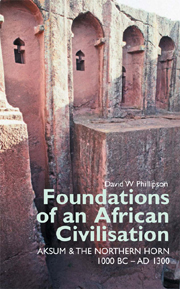Book contents
- Frontmatter
- Contents
- List of illustrations
- 1 General introduction
- Part One BEFORE AKSUM
- Part Two THE KINGDOM OF AKSUM
- 4 Aksumite civilisation: an introductory summary
- 5 Aksumite languages and literacy
- 6 Some written sources relating to Aksumite civilisation
- 7 The emergence and expansion of the Aksumite state
- 8 Aksumite kingship and politics
- 9 Aksumite religion
- 10 Cultivation and herding, food and drink
- 11 Urbanism, architecture and non-funerary monuments
- 12 Aksumite burials
- 13 Aksumite technology and material culture
- 14 Aksumite coinage
- 15 Foreign contacts of the Aksumite state
- 16 Decline and transformation of the Aksumite state
- Part Three AFTER AKSUM
- Bibliographic references
- Index
- EASTERN AFRICAN STUDIES
6 - Some written sources relating to Aksumite civilisation
from Part Two - THE KINGDOM OF AKSUM
Published online by Cambridge University Press: 05 December 2015
- Frontmatter
- Contents
- List of illustrations
- 1 General introduction
- Part One BEFORE AKSUM
- Part Two THE KINGDOM OF AKSUM
- 4 Aksumite civilisation: an introductory summary
- 5 Aksumite languages and literacy
- 6 Some written sources relating to Aksumite civilisation
- 7 The emergence and expansion of the Aksumite state
- 8 Aksumite kingship and politics
- 9 Aksumite religion
- 10 Cultivation and herding, food and drink
- 11 Urbanism, architecture and non-funerary monuments
- 12 Aksumite burials
- 13 Aksumite technology and material culture
- 14 Aksumite coinage
- 15 Foreign contacts of the Aksumite state
- 16 Decline and transformation of the Aksumite state
- Part Three AFTER AKSUM
- Bibliographic references
- Index
- EASTERN AFRICAN STUDIES
Summary
To avoid repetition and encumbrance, basic information is here provided about a number of important written sources for the history of Aksumite civilisation to which frequent reference is made later in this book. Inclusion here is limited to those sources that are further considered in more than one of the thematic Chapters 7–16. Stone inscriptions are considered first, followed by manuscript material. Interpretations based on the content of these sources are discussed in these later chapters; here we are concerned primarily with such matters as their dating, provenance and integrity.
STONE INSCRIPTIONS
In reconstructions of Aksumite political and religious history, the evidence of the long monumental stone inscriptions recording the exploits of kings retains paramount importance, particularly when integrated with the recent achievements of numismatic studies and archaeological excavation. These inscriptions also yield data important in other areas of study that have so far received comparatively little attention. The published literature relating to these texts is very widely scattered, and much of it is not readily available. It is therefore appropriate that this re-evaluation should include a summary of the primary evidence, a guide to sources of more detailed information, and a commentary on some previous interpretations. The texts are in one of two languages: Greek and the local vernacular, Ge'ez. As noted in Chapter 5, two scripts were employed for writing distinct variants of Ge'ez.
- Type
- Chapter
- Information
- Foundations of an African CivilisationAksum and the northern Horn, 1000 BC - AD 1300, pp. 57 - 68Publisher: Boydell & BrewerPrint publication year: 2012



